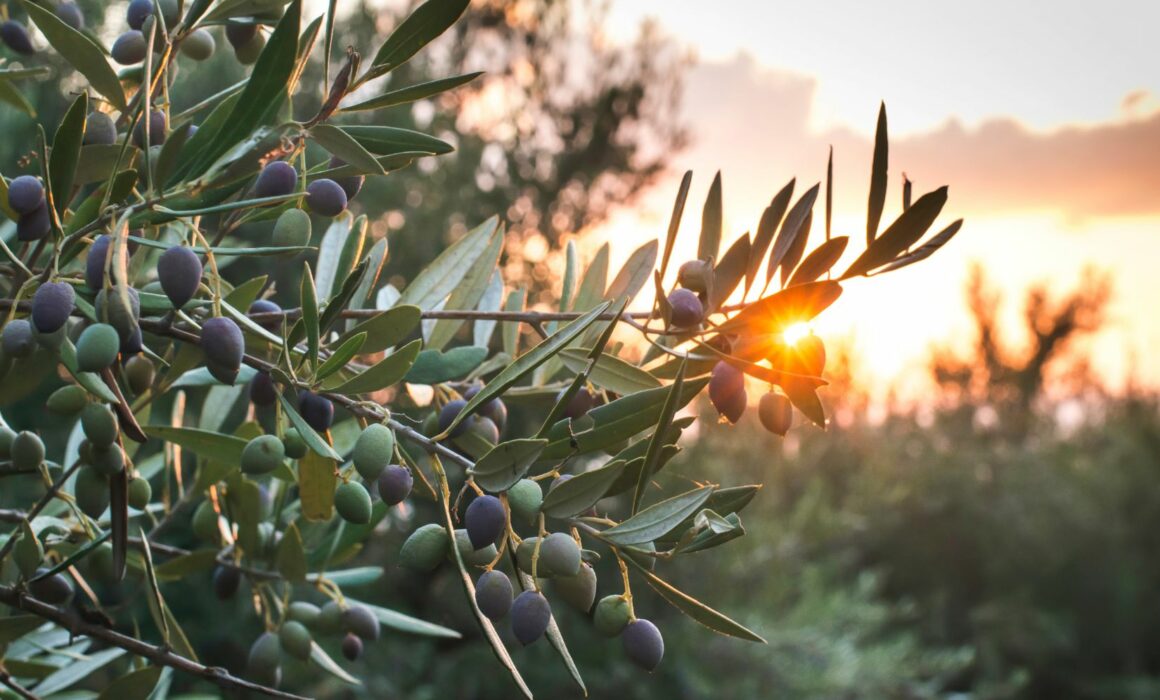Olives are a Tiny but Mighty Sonoma County Crop
By Virginie Boone
Olives don’t make up a majority of Sonoma County’s agricultural crop totals, but they loom large in the region’s history and prestige.
There were only 259 acres of olives accounted for in 2022 – compare that with 57,000 acres of wine grapes and 2,000 acres of apples, or even 6,100 acres of hay, rye and oat. But still, there are many Sonoma County wine lovers out there who also associate its diverse food culture with olives and olive oil.
The olive harvest happens right around now – November and December – with many wineries producing a proprietary olive oil to offer alongside their wines.
B.R. Cohn in Glen Ellen started making olive oil in 1990, the first single-estate olive oil produced in California in over a century. The estate has 450 Picholine olive trees that were imported from France. Nearby neighbor Benziger Family Winery has 950 olive trees that are biodynamically farmed.
The Cline family of Cline Family Cellars and Jacuzzi Family Vineyards runs The Olive Press, making olive oil from estate trees that grow in Sonoma, but also sourcing from orchards within a 150-mile radius.
The Olive Press’s Italian mill does the grinding and was in fact the first olive mill in Sonoma, founded by Ed Stolman and Deborah Rogers in 1995. Rogers told the Sonoma West Times years ago that “olives are our second crop…. People think of us as grapes, but truly there are enough olives grown in this area to make it our second harvest.”
The Clines bought The Olive Press in 2013 and continue to offer custom crush services for local olive growers to make their own olive oil.
DaVero Farms in Healdsburg started importing olive trees from Tuscany in 1990, the first olive trees imported into the United States since the 1800s. They now have thousands of trees at their Olive Ridge Ranch, a mix of Leccino, Frantoio, Maurino and Pendolino. In addition to making olive oil, DaVero also sells olive trees and provides advice on planting them.
Among the advice – olive trees are shallow-rooted and don’t like wind, don’t like cold and don’t like cold feet.
With over 900 olive tree varieties, and multiple clones of each, most orchards in Sonoma County are field blends, but also, olive trees don’t graft well. It’s best to blend the oils from different varieties of trees, though crushing and pressing different varieties separately before blending is good. From 100 to 220 trees per acre is considered ideal and to make oil, at least an acre is required.
Olive trees are more or less drought-tolerant but do need 10-20 gallons of water per tree per week from June through October, DaVero recommends. They need nitrogen and they need to be pruned. It costs an estimated $7,500/acre to plant an orchard of olive trees and about four years before there’s crop.
Trattore Farms in Geyserville sources olives from heritage orchards in the Dry Creek Valley for its Dry Creek Olive Company and has its own mill, donating time on the mill to Farm to Pantry to make its “No One Left Behind” extra virgin olive oil. They also do custom milling for growers who have at least 1 ton of olives and community milling for smaller growers to create a field blend from multiple sites.
Jordan Vineyard and Winery is another olive oil producer, growing 16 acres of trees on its estate since the mid-1990s. Among the types are Frantoio, Pendolino and Leccino from Italy and Arbequina from Spain.
But while many wineries added olives and olive oil to their wine portfolio, McEvoy Ranch in West Marin County’s Petaluma Gap did the opposite, starting with olive oil first. Across 550 acres, only 10% of it planted, to about 14,000 olive trees.
Its namesake, Nan McEvoy, bought the former dairy farm in 1990 determined to make olive oil. She was 72 and soon became a California olive industry pioneer. A former news reporter whose grandfather co-founded the San Francisco Chronicle, McEvoy imported 1,000 seedlings from Italy, including Frantoio, Leccino, Pendolino, Moraiolo, Maurino, Coratina and Leccio del Corno. Soon, McEvoy Ranch was propagating trees from cuttings and selling those trees to growers across the Western United States.
When McEvoy died in 2015 at age 95, her obituary noted that in coming to Sonoma County, “The glamour was in wine, but Mrs. McEvoy always avoided glamour. Explaining why she chose to plant olive trees rather than a vineyard, she told an interviewer: ‘We were too late for grapes – I didn’t want to be the 800th in line.’”
Instead she was “first in line for the California olive oil boom.”
Sonoma County remains a place where so many wonderful things can grow, whether one is first in line or 800th. Cheers to it all.


